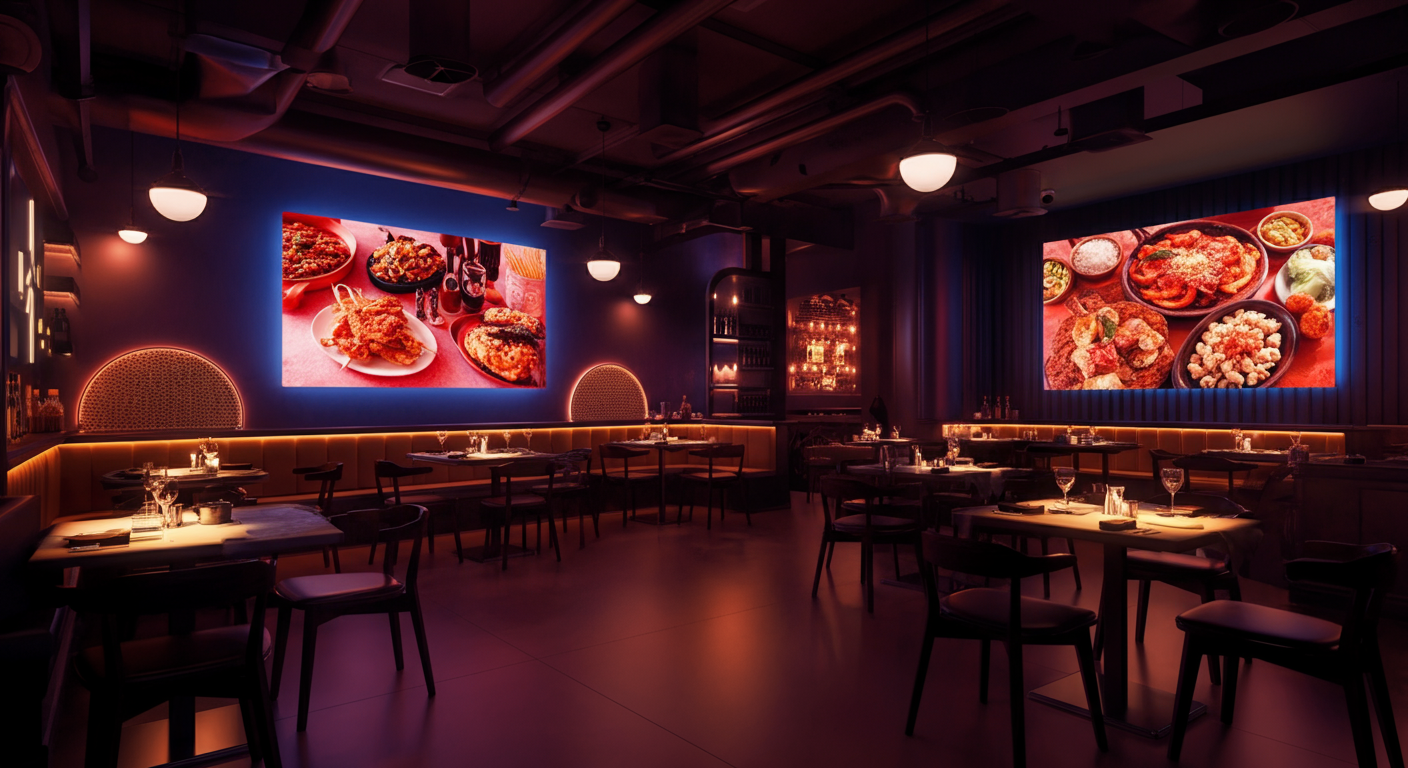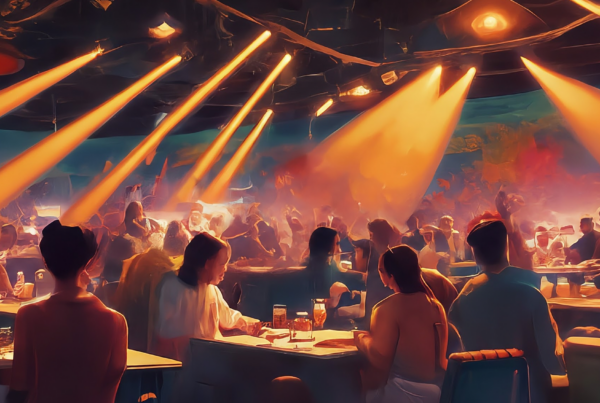In today’s fast-paced digital era, capturing the attention of diners is more important than ever. Restaurants are discovering that traditional methods aren’t enough to keep customers engaged. Enter Innovative Strategies for Restaurant Video Programming, a game-changer in the hospitality industry. Imagine transforming your dining space into a dynamic environment that not only serves delicious food but also captivates your customers with engaging video content. This strategy not only enhances the dining experience but also fosters a vibrant atmosphere that keeps patrons coming back for more.
As businesses in the hospitality sector strive to stand out, integrating video programming into your restaurant’s ambiance can be a powerful tool. It addresses the common pain points of attracting and retaining customers by offering a unique, engaging experience. At DLM Media, we understand the crucial role that high-quality video content plays in commercial entertainment. Our expertise in providing reliable commercial video programming solutions ensures that your restaurant can offer an exceptional viewing experience without any hassle.
Throughout this blog post, we will explore the various facets of implementing video strategies in your restaurant. From choosing the right content to seamlessly integrating it into your dining environment, we will cover everything you need to know. Whether you run a bustling city eatery or a cozy suburban cafe, these insights will help you enhance your customer experience and create a lively atmosphere that sets your restaurant apart. So, let’s dive into the world of innovative video programming and discover how it can transform your business.
Enhancing Customer Experience with Video Content
In the competitive restaurant industry, creating a memorable dining experience is crucial for customer retention and satisfaction. One effective way to achieve this is through the strategic use of video content. Videos not only engage customers visually but also tell a story that resonates with them, enhancing their overall experience. By integrating video content into your restaurant’s ambiance, you can create an environment that captivates and delights your patrons.
Restaurants that successfully use video content often see a significant impact on customer satisfaction and loyalty. Engaging visuals and compelling storytelling can transform a simple meal into an unforgettable experience. This section explores how video content can enhance the customer experience, using examples from successful restaurants and supported by data and case studies.
Creating an Engaging Dining Atmosphere
Video content can significantly enhance the dining atmosphere by providing engaging visuals and storytelling elements. Restaurants can use videos to showcase their culinary expertise, highlight special events, or introduce the team behind the scenes. This creates a dynamic environment that keeps customers entertained and engaged throughout their visit.
For instance, some restaurants use video walls to display stunning visuals of their dishes being prepared. This not only whets the appetite but also gives customers a glimpse into the artistry and effort behind each meal. By incorporating such elements, restaurants can create a unique and immersive dining experience that stands out.
Impact on Customer Satisfaction and Retention
Integrating video content into the dining experience has been shown to positively affect customer satisfaction and retention. According to a study by Vidico, video content can increase brand recall by 95%, helping restaurants stay top-of-mind for customers. Additionally, videos that tell a compelling story or showcase customer testimonials can build trust and credibility, encouraging repeat visits.
Restaurants like Chipotle have successfully used video content to engage customers and enhance their brand image. Their “Whopper Detour” campaign, for example, increased app downloads and customer engagement by offering a unique video-based promotion. Such strategies demonstrate the potential of video content to drive customer satisfaction and loyalty.
Examples of Successful Video Content Strategies
Several restaurants have effectively used video content to enhance their customer experience. For example, Starbucks utilizes customer testimonials to create authentic and relatable content that resonates with their audience. By sharing real customer stories, they build a community and foster a sense of belonging among their patrons.
Another successful example is the use of behind-the-scenes videos by restaurants to showcase their chefs and kitchen operations. This not only humanizes the brand but also provides transparency, which customers appreciate. By giving a glimpse into the culinary process, restaurants can create a deeper connection with their audience.
Innovative Video Programming Techniques
In the ever-evolving landscape of the restaurant industry, adopting Innovative Strategies for Restaurant Video Programming can set your establishment apart. As digital technology advances, restaurants have the opportunity to leverage video content in creative ways to enhance customer interaction and engagement. By utilizing digital signage and interactive videos, restaurants can transform their spaces into dynamic environments that captivate diners and enhance their overall experience.
Digital signage, for instance, offers a versatile platform for displaying a variety of content, from menu specials to promotional offers. This technology not only attracts attention but also allows for real-time updates, ensuring that your messaging is always relevant and timely. Meanwhile, interactive videos engage customers on a deeper level, inviting them to participate in the content and creating a memorable dining experience.
Utilizing Digital Signage for Dynamic Displays
Digital signage has become a cornerstone of modern restaurant video programming. These dynamic displays can be used to showcase everything from daily specials to upcoming events. By integrating high-quality visuals and animations, digital signage captures attention and enhances the dining atmosphere. Restaurants can customize content to reflect their brand identity, ensuring a cohesive and engaging customer experience.
One of the key benefits of digital signage is its flexibility. Restaurants can easily update content to highlight seasonal promotions, new menu items, or special events. This adaptability ensures that your messaging remains fresh and relevant, drawing customers’ attention and encouraging repeat visits. Additionally, digital signage can be strategically placed throughout the restaurant to maximize visibility and impact.
Interactive Videos for Enhanced Engagement
Interactive videos offer a unique way to engage customers by allowing them to interact with the content. This innovative approach transforms passive viewers into active participants, creating a more immersive dining experience. For example, restaurants can implement touch-screen menus that provide detailed information about each dish, including ingredients and preparation methods.
Furthermore, interactive videos can be used to tell the story of your restaurant, showcasing the passion and creativity that goes into each dish. By incorporating elements such as chef interviews or behind-the-scenes footage, restaurants can create a personal connection with their customers. This approach not only enhances engagement but also builds trust and loyalty, encouraging customers to return.
Incorporating Cutting-Edge Technologies
To stay ahead in the competitive restaurant industry, embracing cutting-edge technologies is essential. Augmented reality (AR) and virtual reality (VR) are increasingly being used to create immersive dining experiences. These technologies allow customers to explore virtual menus or take virtual tours of the restaurant, providing a unique and memorable experience.
Moreover, integrating AI-driven analytics can provide valuable insights into customer preferences and behaviors. By analyzing data from video interactions, restaurants can tailor their offerings to better meet customer needs, enhancing satisfaction and loyalty. These technologies not only improve the customer experience but also provide a competitive edge in a crowded market.
Measuring the Impact of Video Strategies
In the competitive landscape of the restaurant industry, deploying Innovative Strategies for Restaurant Video Programming is just the beginning. The real challenge lies in measuring the effectiveness of these strategies to ensure they contribute to your business goals. Understanding how to evaluate the impact of video content can help you refine your approach and maximize returns on your investment.
To accurately assess the success of your video strategies, it’s essential to focus on specific metrics and employ robust analytics tools. This section explores key performance indicators (KPIs) and tools that can provide valuable insights into your video content’s performance, helping you make data-driven decisions.
Key Performance Indicators for Video Success
Identifying the right KPIs is crucial for evaluating the impact of your video strategies. Some essential metrics include:
- View Count: This indicates the reach of your video content and helps measure its popularity.
- Engagement Rate: Analyzing likes, comments, and shares can provide insights into how well your content resonates with viewers.
- Watch Time: This metric helps you understand how long viewers are watching your videos, indicating their interest level.
- Conversion Rate: Tracking how many viewers take a desired action, such as visiting your restaurant or making a reservation, can measure the direct impact on your business.
By focusing on these KPIs, you can gain a comprehensive understanding of your video’s performance and its contribution to your restaurant’s success.
Analytics Tools for In-Depth Insights
To effectively track and analyze your video content’s performance, utilizing advanced analytics tools is essential. Platforms like Google Analytics, YouTube Analytics, and social media insights provide detailed data on viewer demographics, engagement patterns, and more.
For instance, Google Analytics can help you track website traffic generated from your video campaigns, while YouTube Analytics offers insights into viewer retention and audience demographics. These tools enable you to identify trends, optimize content, and tailor your strategies to better meet your audience’s preferences.
Interpreting Data and Adjusting Strategies
Interpreting the data collected from your analytics tools is key to refining your video strategies. Look for patterns in viewer behavior, such as peak engagement times or popular content types, and adjust your approach accordingly.
For example, if you notice that interactive videos receive higher engagement, consider incorporating more interactive elements into your content. Additionally, if certain videos lead to increased conversions, analyze what makes them successful and replicate those elements in future content.
By continuously monitoring your video’s performance and making data-driven adjustments, you can enhance the effectiveness of your video strategies and ensure they align with your restaurant’s objectives.
Elevate Your Restaurant Experience with Video
As we wrap up our exploration of Innovative Strategies for Restaurant Video Programming, it’s clear that integrating video content into your restaurant’s ambiance can revolutionize the dining experience. By utilizing digital signage and interactive videos, you not only captivate your patrons but also enhance their overall engagement. These strategies are more than just trends; they are powerful tools for transforming your establishment into a dynamic environment that customers will want to revisit.
Throughout this blog post, we’ve delved into how video content can improve customer satisfaction and foster loyalty. From showcasing your culinary expertise to offering behind-the-scenes insights, these visual narratives create a memorable and immersive dining atmosphere. Successful examples from industry leaders like Chipotle and Starbucks illustrate the significant impact of video programming on brand recall and customer retention.
Here are some key takeaways to consider when implementing video strategies in your restaurant:
- Engage with Digital Signage: Use dynamic displays to highlight menu specials and events, ensuring your messaging is always fresh and relevant.
- Leverage Interactive Videos: Transform passive viewers into active participants, enhancing their dining experience through engaging content.
- Incorporate Cutting-Edge Technologies: Consider using AR, VR, and AI-driven analytics to personalize customer interactions and gain valuable insights.
As you embark on this journey of integrating video programming, don’t hesitate to explore more resources available on DLM Media for tailored solutions that fit your unique needs. We invite you to share your thoughts, questions, or experiences in the comments below. Your insights could inspire others in the community to embrace these innovative strategies.





